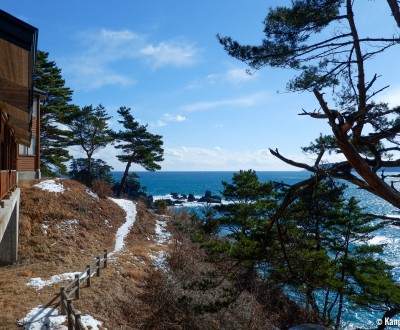Sanriku Coast
The long dramatic coastline of Japan
The Sanriku Coast or Sanriku Kaigan is located on the shore of the Pacific Ocean, on the northeast of Japan’s main island Honshu. It spans three prefectures: from the north of Miyagi prefecture, through Iwate, and to the south of Aomori. The vivid nature of the area offers wonderful rocky landscapes, as well as temples and museums for discovery.
A 7,5 magnitude earthquake (6+ on the Shindo scale) struck the north of Sanriku Coast (especially Hachinohe port in Aomori Prefecture) on December 8th, 2025.
The local JR train line between Hachinohe and Kuji has been damaged and is currently out of service until further notice.
The impressively irregular Sanriku Coast is one of the natural gems of the Tohoku area, if not the most iconic. The coast is characterized by a sculptural aspect with high cliffs, protruding rocks, caves, peninsulas, creeks, white sand beaches 🏖, and cobalt blue waters. The sea erosion shaped Sanriku Kaigan and formed what is called, in geological terms, a ria, meaning an ancient valley of a coastal river now immersed in the ocean. Sanriku Kaigan is the longest ria coast of Japan, with 200 kilometers of marvelous rock indentations.
Partly devastated by the 2011 Tohoku Earthquake, the region’s government worked hard to rebuild the touristic attractiveness. Tohoku’s inhabitants are unfortunately accustomed to frequent destructions by tsunami and have developed skills that helped in the reconstruction effort. Thanks to the organization of the 2019 Rugby World Cup in Kamaishi, funding for reconstruction was increased, and the main touristic spots were upgraded with English language signs.
Below is a short list of visits to plan as soon as possible:
- Kitayamazaki Coast, the symbol of this coastline;
- Jodogahama Beach, beautiful and popular;
- the mysterious Ryusendo Cave;
- the surprising Kuji Amber Museum; and
- the great Kamaishi Daikannon Statue.
The Sanriku Coast can be explored in many ways: on foot or by boat and from the top of the ridges to the depths of the Earth. It is even possible to find good French cuisine at the restaurant L’Auréole, which is in the south of Kitayamazaki and hidden among the maritime pines. The restaurant provides a wonderful view of the ocean.
The ocean is a predominant element, but so is the coniferous forest that borders a large part of the coast. The forest is a natural home for sea birds and brings a touch of green to the coast. The Sanriku Coast is part of the Rikuchu Kaigan National Park, which has been a part of the Sanriku Fukko Park (Sanriku Reconstruction Park) since 2013.
The National Road 45 follows the Sanriku Coast and connects the cities of Sendai and Towada. A car 🚙 or motorcycle is the main means of transportation in the area. The main coastal cities are reachable thanks to the network of JR trains 🚅. It is thus possible to consider a trip by public transportation, but it will be longer and more complicated than traveling with a rental car. One of the consequences of the 2011 tsunami is an irregular frequency of public buses; it is strongly advisable to check the schedules beforehand.

